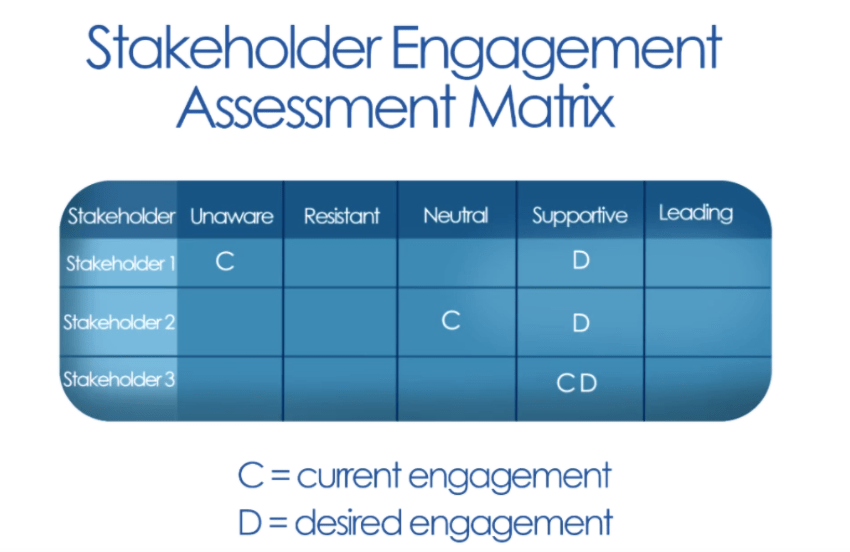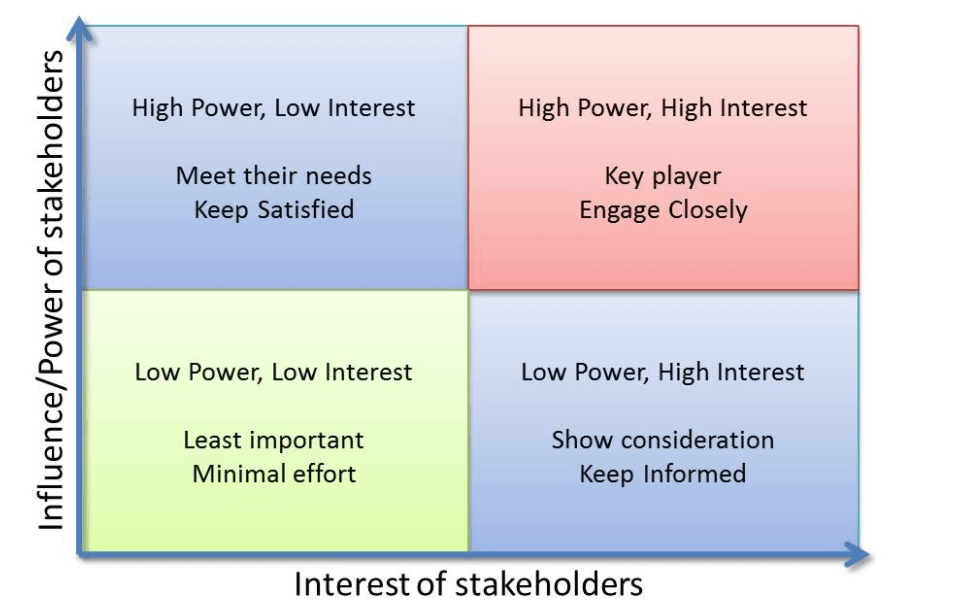We’ve all got stakeholders nosey-ing around in the minutiae of our lives.
Your boss? Stakeholder.
Mortgage company? Stakeholder.
Mother-in-law. You betcha.
While we might sometimes prefer to keep them at arm’s length — simmer down, Ellen, I’m just kidding — it’s usually more prudent to keep them engaged and reassured.
It’s the same with projects. Every project has a list of stakeholders, and you need to figure out the best engagement strategy to deal with each of them.
A stakeholders engagement assessment matrix helps you do just that.
In this article, we’ll explain what a stakeholders engagement assessment matrix is, what it isn’t, the benefits of having one, and the easiest way to create one.
What is a stakeholders engagement assessment matrix?
Apart from 41 characters of project jargon, a stakeholders engagement assessment matrix is a model which a project manager uses to judge stakeholders’ current level of engagement with a project.
Stakeholders can be categorized in 5 different ways:
- Unaware. In this first level, stakeholders are unaware of the project and any potential impacts its outcome may have on them.
- Resistant. Stakeholders in this category are aware of the project and are resistant to the change.
- Neutral. Neutral stakeholders are aware of the project but are neither resistant to or supportive of it.
- Supportive. These stakeholders are aware of the project and its potential impact and are supportive of the change.
- Leading. Stakeholders in this category are aware of the project and are actively working to ensure its success. These stakeholders may be termed ‘change champions.’
As well as defining the current level of engagement, the matrix can also be used to inform a discussion about the desired engagement level of each stakeholder or stakeholder group.
What does it look like?
A classic stakeholders engagement assessment matrix is made up of rows and columns.
Each stakeholder or stakeholder group is listed down the left-hand side, with their status across the top.
Within the grid, the current and desired engagement status of each stakeholder is added.

What are the benefits of a stakeholders engagement assessment matrix?
There are many key benefits in identifying how stakeholders currently feel about the project. Armed with this information, project managers can:
Grow project support
By identifying those stakeholders who are broadly supportive of — or actively championing — the project, the team can target communications to ensure their continued support.
Making sure those stakeholders have the most up-to-date information — and encouraging them to share that information with others — can be a significant step toward preparing the business for an upcoming change.
This is especially true for stakeholders who are influential and trusted by others in the organization.
Build awareness and engagement
Surprising people with an unwanted or difficult change is one of the quickest ways to negatively impact the likelihood of project success.
People like to be kept in the loop with what’s happening and given a chance to engage with and provide feedback on the changes.
By identifying those stakeholders who appear to be unaware of the project, the team can build an effective communications management plan focused on increasing their awareness and engagement.

The project team may be able to turn them into champions for the change, or they may offer beneficial feedback that wouldn’t have surfaced had they remained unaware.
Note: occasionally keeping stakeholders unaware is a deliberate move by the project team. Perhaps the project is highly sensitive and could result in job loss. In that case, the team may choose to keep stakeholders unaware until appropriate support mechanisms are established.
Convert resistant or neutral stakeholders
Finally, using a stakeholders engagement assessment matrix helps you identify and target resistant or neutral stakeholders.
This is important, as it allows the project team to explore why they hold that position.
Perhaps they perceive the future state as less beneficial. Or maybe the organization has tried to make the same change previously and failed. Or they’re worried about whether they have the right skills for the future.
Whatever the reason, exploring and understanding it gives the team an opportunity to influence their position.
That might be targeted updates to show positive project progress comparative to failed projects. Or it could be sharing the training and development plans that will help people feel ready for change.
It might even just be an acknowledgment of their concerns. Sometimes, making people feel heard is all that’s needed to help them get on board.
How does it differ from other stakeholder models?
There are several different stakeholder analysis models, with the power vs. interest model as possibly the most well-known.
Once stakeholders are identified, they’re arranged on a 2×2 grid based on their perceived level of power and interest in the project.

Based on this analysis, the project team can decide how they should engage with various key stakeholder groups and create a stakeholder management plan.
Understanding the level of influence stakeholders have on a project is important. Influential, supportive stakeholders can champion the project. Influential, resistant stakeholders can sabotage the project.Sabotage can be operational. Resistant stakeholders require more communication effort, which can increase project duration and cost. This can impact project progress and reinforce the opinion that the project is doomed to fail.
Sabotage can also be more strategic. If influential stakeholders don’t agree with the project, they may push for its closure on the basis it doesn’t create business value.
Given this, a targeted stakeholder engagement strategy should be used for each of the 4 sections of the power vs. interest grid.
Stakeholder engagement is a key form of stakeholder management. This is the action taken, based on your analysis, to move your stakeholders to positions that increase the likelihood of a successful project outcome.
The important thing with all the stakeholder matrix models is that you do something with the insight gained from your analysis.
Whether that’s engaging an interested, supportive stakeholder to become a champion for the project, or effectively managing an influential, resistant stakeholder, so the project isn’t negatively affected, the action is what counts.
How to create a stakeholders engagement assessment matrix using monday.com
To create a stakeholders engagement assessment matrix, the first step is to identify the project stakeholders. This is done at the project initiation phase and stated in the project proposal.
It’s unlikely the stakeholder analysis can be done by the project team alone, so this should be done in conjunction with representation from the business. The outcome from the analysis can be captured in monday.com’s fully customizable stakeholder register template.

Color-coding makes it easy to track the status of each stakeholder. Both ‘Current’ and ‘Desired’ tags can be added.
The stakeholders engagement assessment matrix isn’t meant as a static one-off tool. Regular review enables the project team to identify which stakeholder management tactics may be working.
monday.com makes it simple to share, view, and update documents in real-time. Seek input by tagging others and collaborate with ease, both in-platform or through integration with your favorite communication tools.
If you’re new to monday.com and you have this information stored elsewhere, monday.com’s integrations with tools like Excel make transferring information simple.
Plus, if a stakeholder’s status changes, you can use monday.com automations to trigger action. For example, any stakeholders whose status changes to ‘Leading,’ could be sent an email inviting them to a workshop on the role of change champions.
Using a stakeholders engagement assessment matrix keeps you ahead of the game
In this article, we’ve outlined what a stakeholders engagement assessment matrix is and how you can use it to maximize support for your project.
Without a conscious awareness of how your key stakeholders feel about your project, you might be missing opportunities for them to champion it. Equally, you might be blind-sided if influential stakeholders resist, or even sabotage your project efforts.
monday.com can help you gather the information you need to effectively manage your stakeholders. Why not get started with our stakeholder register template?
